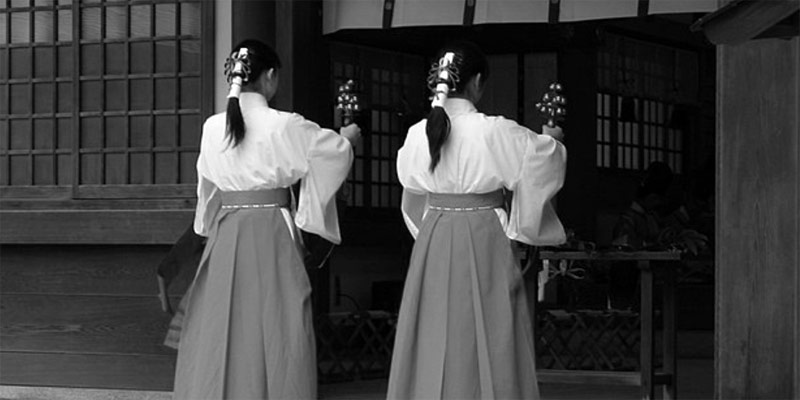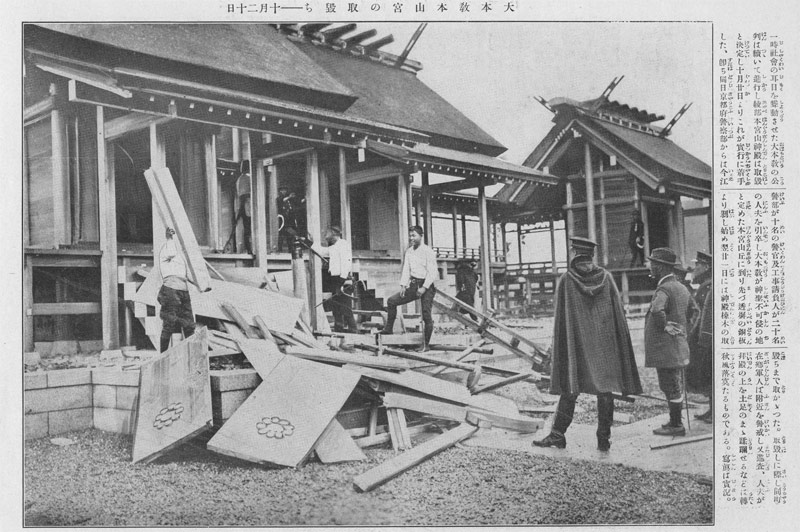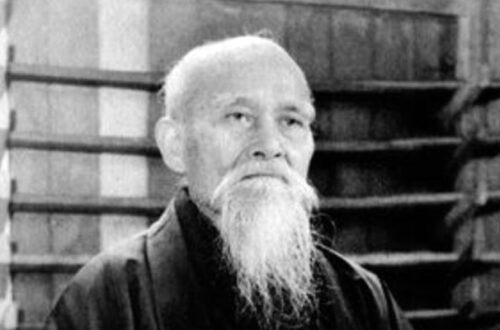
The Rise of a New Religion That Shaped Aikido and Sparked the First Omoto Incident
In the early 20th century, Japan witnessed the rise of Omoto 大本 (commonly called Omoto-kyo 大本教, though the formal name omits the “kyo” meaning religion). Its teachings significantly influenced the development of Aikido. Morihei Ueshiba, the founder of Aikido, was known to be a devoted follower of Omoto. However, the religion’s perceived unconventional teachings and political influence attracted the scrutiny of the Japanese government. The first major suppression of Omoto occurred in the early 1920s, marking a turbulent chapter in its history.
Omoto-kyo, often considered a new Japanese religion with roots in Shinto 神道, was founded by Nao Deguchi 出口直. Nao, an ordinary housewife from the small town of Ayabe, claimed to have been possessed (kamigakari) by a spirit called Ushitora no Konjin 艮の金神 in 1892. The spirit prophesied the end of the world and foretold the arrival of a savior who would create heaven on earth. Despite being illiterate, Nao began dictating the Reikai Monogatari 霊界物語 in the form of Fudesaki 御筆先 (automatic writings common among Shinto mediums) whenever the spirit spoke to her. In 1895, she became a teacher of Konko-kyo 金光教, and in 1898, she met Kisaburo Ueda 上田喜三郎. Together, they established the Kinmei Reigakkai 金明霊学会 in 1899. Ueda later married Nao’s fifth daughter, Sumi Deguchi 出口澄, who became the second-generation spiritual leader of Omoto-kyo. Ueda adopted the name Onisaburo Deguchi 出口王仁三郎. The group rapidly grew, attracting many followers, and took on various names over time, including Dai Nihon Shuseikai 大日本修斎会, Kodo Omoto 皇道大本, and finally, Omoto.
It is believed that Morihei had heard about the religion while in Hokkaido. In 1919, on his way back to see his dying father, he detoured to Omoto-kyo’s headquarters in Ayabe, perhaps hoping the religion could bring about a miracle to save his father. There, he met Onisaburo and soon became a dedicated follower. After his father’s death, Morihei even relocated to Ayabe with his family to immerse himself fully in the Omoto-kyo community.

Hundreds of armed police raided major Omoto locations in February 1921
Between 1919 and 1921, Omoto experienced a period of intense expansion. The movement established a new headquarters in Kameoka 亀岡, opened branch offices in Tokyo, and sent missionaries across Japan and even to Taiwan. They also established printing facilities, published periodicals, and actively used mass media for proselytizing. Omoto’s teachings emphasized harmonious alignment with all life and the universe, and Onisaburo openly criticized the Imperial Japanese government’s increasingly militaristic policies. The government began to view Omoto with suspicion, deeply concerned about its potential to challenge state ideology and incite unrest. These concerns culminated in 1921 when the government initiated a crackdown on the movement.
In February 1921, the chief of public prosecution ordered hundreds of armed police to raid and search more than 20 major Omoto locations, believing that the group was armed. Though no weapons were found, leaders of the organization, including Onisaburo, were arrested on charges of lese-majesty and violations of the Newspaper Law. The government accused Omoto-kyo of undermining the imperial institution, a grave offense in Japan’s socio-political landscape. Whether these charges were legitimate or not, they had a profound and lasting impact on public opinion toward Omoto. Onisaburo was tried and sentenced to five years in prison, though he was granted bail after serving about four months. The legal battle dragged on for several years, until a pardon was granted in connection with the funeral of Emperor Taisho 大正天皇, ending the trial.

A shrine in Ayabe was demolished
This crackdown led to the disbandment of Omoto. Many of its shrines and buildings were demolished, and its members faced widespread persecution. The group’s membership, including its leadership, was dramatically reduced. However, during Onisaburo’s imprisonment, Morihei remained a loyal follower, patiently awaiting Onisaburo’s release. Afterward, he worked closely with him to help rebuild Omoto in the years that followed.
The 1921 suppression, known as the First Omoto Incident 第一次大本事件, was just the first of several challenges the movement would face from the Japanese government. Authorities sought to limit Omoto’s influence, viewing it as a potential threat to the imperial government. Despite these adversities, Omoto persevered, adapting to the shifting political landscape in the decades that followed.
Suggested Reading: Religious Repression in Prewar Japan: Morihei Ueshiba, Onisaburo Deguchi, and the Second Omoto Incident
Author’s Note: We appreciate your readership! This article serves as a preliminary introduction to the subject matter. While we aim for accuracy, we cannot guarantee the content’s precision and it may contain elements of speculation. We strongly advise you to pursue additional research if this topic piques your interest. Begin your AikidoDiscovery adventure! 🙂





One Comment
Eiichi
Very interesting, it might lead to the lack of structure or even responsibility that Aikido is facing nowadays or even the interpretation of Peace being part of a Cult that it might had their own agenda.